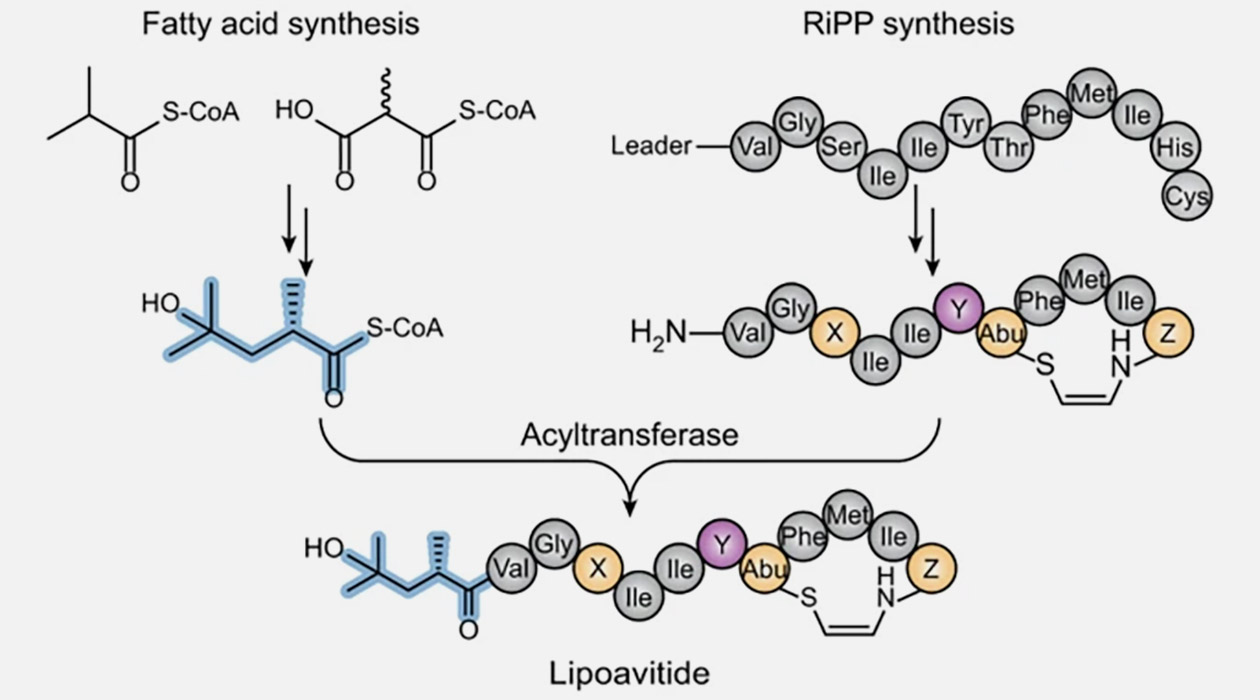Researchers discover a new natural product, a RiPP-fatty acid hybrid molecule

Living organisms produce a diverse suite of natural products which can be harnessed for medicinal and therapeutic purposes. Among these products, ribosomally synthesized and post-translationally modified peptides, or RiPPs, have garnered increasing attention.
Recently in a new study published in Nature Chemistry, a team of researchers at the University of Illinois Urbana-Champaign uncovered a novel class of hybrid gene clusters, that combines elements of RiPP biosynthesis with enzymes responsible for fatty acid synthesis. They named this newly discovered RiPP hybrid ‘lipoavitide’.
While hybrid gene clusters containing machinery from multiple natural product families are not uncommon in nature, only a few RiPPs have been found to be synthesized by such hybrid machinery. According to Huimin Zhao (BSD theme leader/CABBI/CGD/MMG), Steven L. Miller Chair of Chemical and Biomolecular Engineering at Illinois and anchoring author on the study, hybrid molecules theoretically possess increased versatility and functionality due to their mixed origins from different natural product classes, making them highly sought after.
“We're always interested in looking for novel RiPPs, and by definition, hybrids are novel because they give way to new structures,” said Zhao. “However, even though they occur naturally, they have been rarely studied. There are only three examples in the past that have shown that RiPPs can actually be fused with another class of natural products’ biosynthetic machinery to make hybrid compounds.”
Using advanced bioinformatics tools, the researchers first identified RiPP gene clusters of interest within Streptomyces bacteria. They then looked within these clusters for additional genes associated with other classes of natural products.
Ultimately, they identified a cluster that included a gene linked to fatty acid biosynthesis.
The researchers then employed a method called ‘Cas12a assisted precise targeted cloning using in vivo Cre-lox recombination’, or CAPTURE for short, to extract the target DNA fragment containing the gene cluster that encodes the lipoavitide from its native host. The fragment is then cloned and expressed in a more manageable host organism, like Escherichia coli.
Lipoavitides are uniquely amphiphilic, consisting of both a hydrophobic fatty acid and a hydrophilic peptide. This allows them to interact with the membranes of cells, which also have both hydrophobic and hydrophilic components, something that peptide-based RiPPs alone cannot do.
While testing the lipoavitides for bioactivity, Zhao’s team discovered that the fatty acid component of the molecule also allowed for hemolytic activity, the ability to break down the cell walls of blood cells, which could have potential applications in medicine.
Zhao envisions lipoavitides as prototypes for the creation and discovery of other RiPP/fatty acid hybrids. Structural similarities between lipoavitides and other ribosomally synthesized peptides, such as thioamitides (which are used to treat thyroid hyperactivity), indicate further avenues for exploration into their biological functions.
The team hopes that new assays will allow for continued investigation of the bioactivity of these hybrid molecules.
“The challenge in natural product discovery is that we’re limited by the assays we can perform, which can make it hard to find the true application for the natural product,” explained Zhao. “We found that the fatty acid component allows for hemolytic activity, but we don’t know what the exact target of this is. But publishing this work is the first step, and it allows for others to approach us with new tests or assays that might uncover its true bioactivity.”
The discovery and characterization of lipoavitides represent a significant advancement in understanding the biosynthesis of ribosomally derived lipopeptides. Moreover, it opens up promising pathways for leveraging hybrid biosynthetic pathways in drug development, potentially leading to the creation of innovative therapeutics.
The study was funded by the National Institutes of Health, and can be found at DOI: 10.1038/s41557-024-01491-3

